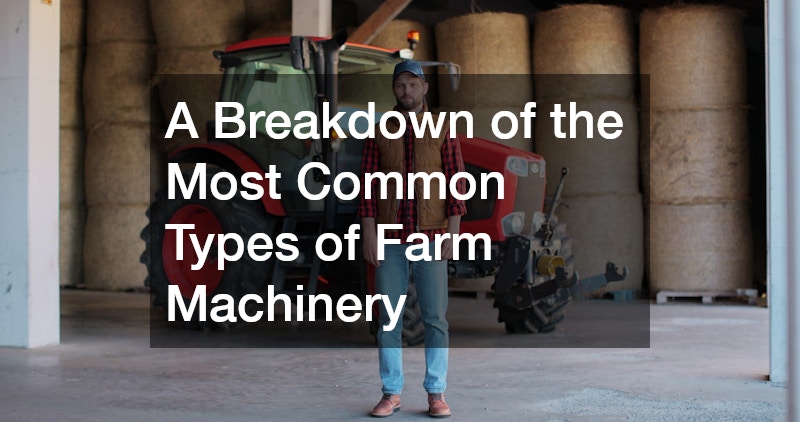Farmers today rely on more than just experience and favourable weather—they depend on efficient, purpose-built machines. From soil preparation to harvest, farm equipment has revolutionised how agricultural tasks are completed, saving time and labour while boosting productivity. In Australia, where farming spans a vast range of climates and terrains, having the right equipment is crucial. Here’s a breakdown of the most common types of farm machinery and how they contribute to modern farming.
Tractors: Versatile Workhorses
Tractors are the backbone of any farming operation. These versatile machines can be fitted with various attachments to perform a wide range of tasks, including ploughing, planting, mowing and transporting materials.
Available in different sizes and power levels, tractors suit everything from small farms to broadacre cropping enterprises.
Today’s tractors often feature GPS technology, auto-steering and climate-controlled cabs, providing precision and comfort. Their adaptability makes them a must-have for nearly all types of farming.
Ploughs & Cultivators: Preparing the Ground
Before planting, it’s crucial to prepare the soil to ensure optimal conditions for seed germination and root development. Ploughs and cultivators are the primary machines used in this phase. Ploughs break up compacted soil, turning it over and aerating it to promote moisture retention and nutrient distribution. This process also helps control weeds and pests.
Cultivators follow ploughs in many operations. They further break down clods and smooth the seedbed. In no-till farming systems, disc cultivators and harrows are often used to loosen the surface without disturbing deeper soil layers. These tools are particularly valuable in areas with varying soil types and seasonal weather patterns, like those found across rural Australia.
Seeders & Planters: Efficient Planting
Getting seeds in the ground accurately is key to crop success. Seeders and planters ensure that seeds are placed at the correct depth and spacing for optimal germination. Seed drills are used for grains, while row planters suit crops like corn and soybeans.
Advanced models include variable rate technology and automatic depth control, reducing seed waste and improving yields. For large-scale farms, this precision translates into big savings and consistent performance.
Sprayers & Spreaders: Input Management
Once crops are in the ground, they need water, fertiliser and protection from pests and disease. This is where sprayers and spreaders come into play. Boom sprayers distribute herbicides, pesticides and liquid fertilisers evenly across paddocks. Some models are mounted on tractors, while others are self-propelled with high-clearance designs that can move through mature crops without damage.
Fertiliser spreaders are used to apply granular nutrients and lime. Precision application is key to avoiding overuse and runoff, and many spreaders now incorporate GPS mapping to target specific areas of need. These machines ensure inputs are applied where they’re most effective, contributing to sustainable farming practices.
Harvesters: Streamlining the Finish
Harvesters or combines are among the most advanced and costly types of farm machinery. They perform multiple functions simultaneously—cutting, threshing, separating and cleaning crops like wheat, corn, canola and legumes. These machines significantly reduce the time and labour required for harvesting.
Modern combine harvesters are equipped with onboard computers, sensors and grain quality monitoring systems. These tools assist in making real-time decisions that improve efficiency and reduce losses. Header attachments can be swapped to suit different crops, adding flexibility for mixed farming operations.
Balers & Hay Tools: Fodder Management
For livestock operations, balers and associated hay equipment are indispensable. Mowers cut the grass or cereal crops, tedders fluff and aerate the hay for faster drying and rakes gather it into windrows. Balers then compact and wrap the dry material into bales—round or square—for easy transport and storage.
Efficient hay management ensures a steady feed supply through dry seasons and can contribute to extra farm income when sold. The choice of baler and hay tools depends on the scale of the operation and the type of fodder being harvested.
Specialised Farm Equipment
Some operations require industry-specific machines. Vineyards might use narrow tractors and sprayers; dairy farms may rely on feed mixers and manure spreaders; and horticultural businesses might invest in transplanters or mulchers.
These specialised tools help farmers tailor their equipment to match unique needs, improving results and saving resources.
Machinery That Moves Agriculture Forward
Farm machinery continues to shape Australian agriculture by improving efficiency, reducing manual labour and supporting sustainable practices. From basic soil prep to high-tech harvesting, each machine has a clear role in the production process.
Choosing the right farm equipment not only improves daily operations but also contributes to long-term productivity. With innovation driving the sector forward, today’s machines offer farmers more control, precision and power than ever before.




